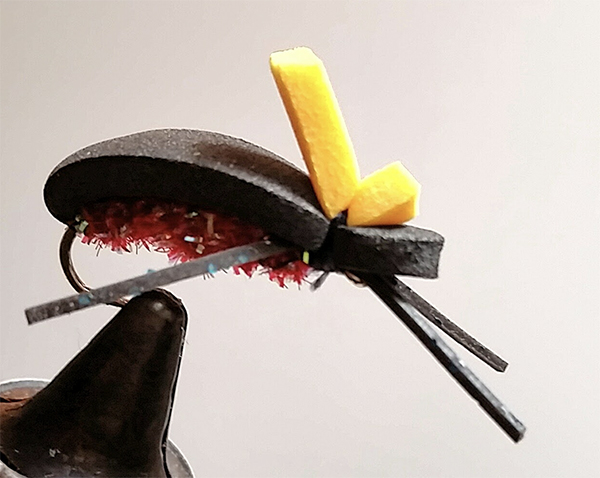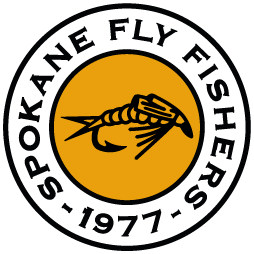By Doug Keene

One of the best flies to use when others are not working on local rivers of the Northwest is the foam beetle. There are many variations on this look-alike fly, but this basic design is easy to tie, is quite hardy, and fast enough to tie that you can create lots of them in a very short time. I am offering several alternatives to keep them from being boring. Get creative!
Recipe
Hooks: Use Dai-Riki #300 or Daiichi 1310, #12 to #8 or equivalent.
Thread: Black 8/0 or 6/0
Legs: Tarantula Legs (mini) or Flex-Floss, Black
Body: 2 mm black or 1.5 mm glitter-black (Silly Winks) Foam (Hobby Lobby)
Abdomen: Midge Cactus Chenele, red, Dark Brown, or Black
Indicator: 2mm orange or yellow foam
Procedure
- Debarb the hook and mount in vise
- Dress the hook from just behind the eye to just over the hook barb, and apply a thin layer of super-glue to the dressing.
- Wind the thread back to right behind the eye.
- Cut a ¼ inch strip of black foam about 4 inch long
- With foam strip on top of hook, just behind the eye, wrap thread tightly all the way back to the end of the thread base, squeezing foam down against hook..
- Attach Cactus Chenille above hook barb, and wrap thread back half way to the eye. You may want to again apply super glue to top of hook.
- Tie on 2-3, 2-inch legs, in a star format, with all legs horizontal and equal on both sides. Then wrap the thread forward to the eye. You should end up with 4 or 6 legs.
- Wrap the Chenille forward to near the eye and tie off.
- Apply spot of super glue to tie off point on top of body.
- Bring the foam strip forward, using fingers to fold sides down evenly, and tie off very securely with multiple wraps of the thread, just behind the eye.
- Trim off the extra foam 1/8 inch to ¼ inch past the eye, depending on size of hook and trim to make a softly rounded or pointed shape for the head.
- For the indicator, cut a 1/8 inch strip of foam, ½ inch long, and attach to top of black foam, behind the eye, tying with 1/3 in front of thread and 2/3 behind.
- Whip finish.
- Trim legs to about ½ inch long.
Fish as a dry fly near shore or pretty much anywhere fish may be hungry.
